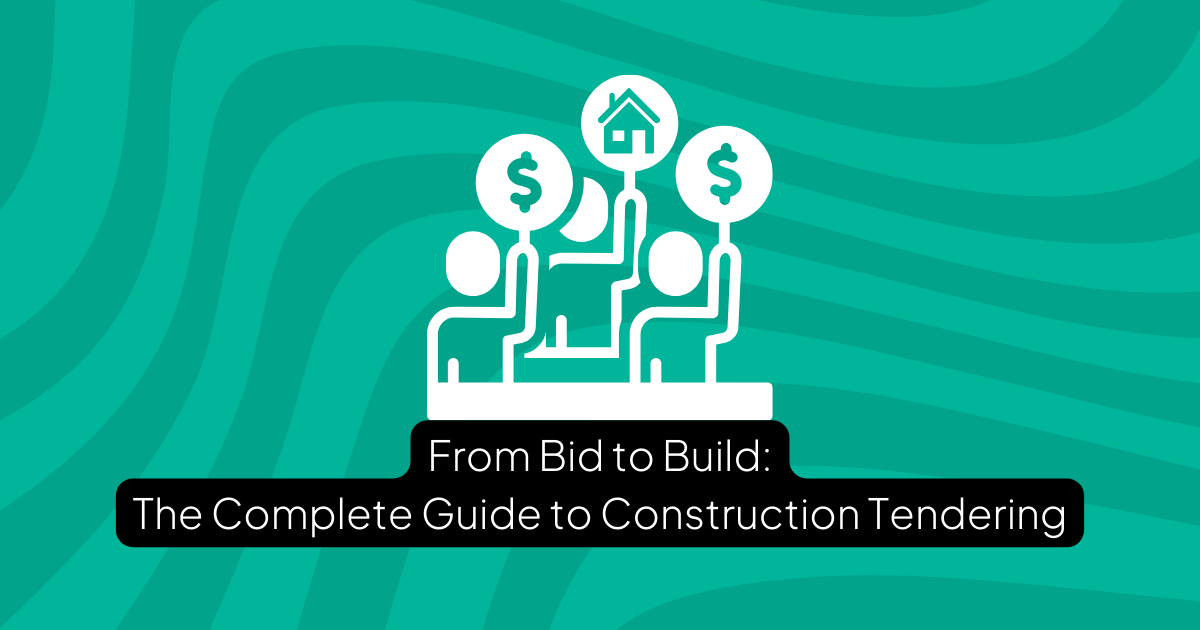
Construction tendering is a necessary evil in the building industry, but it’s surprisingly easy to understand. Let’s begin with the basics of what one is below.
Construction Tenders
A tender is a formal document offered to contractors/businesses outlining what is required for a project to be conducted and asking for a price for the work. Tendering is the process of offering, responding, quoting, negotiating and finalising a contract for that project.
A construction tender is always linked to a project of some kind, as construction work requires the gathering of specific skills, materials, and timelines. Clients want to find the right fit for the job within budget, and businesses want clients, fair contracts and income.
For a new construction business, your first successful construction tender can be your foot in the door, connecting you with larger clients and building your network. For an established business, construction tenders comprise the efforts of past jobs and feed your opportunities to grow your current client base.
So, where to get started?
The Tender Process
The construction tender process itself is involved and requires commitment throughout. As with the varied scales of the construction process, the tender itself could outline anything from concrete footpaths for a local park to rebuilding a leisure centre.
The process itself is simple: the details can get tricky!
Pre-Tender
This is the step when the client prepares all the documents and specifications for their tender. This is where they hash out what they want before getting it out there.
Tender Requests
The client advertises their construction tender request where it can be seen by relevant businesses/contractors. The kind of tender in question will decide where a tender will be posted publicly and which businesses will get a chance at the work. Some will be available to all; others will be sent directly to a preferred construction company.
The information on request may include design drawings, form of contract, site management plans, building information modelling, timescale of the tender and project, pricing schedule, etc. It depends on the request itself. This info should also include a deadline for tender responses to be submitted and the format for it.
This is when you can assess if the tender request is the right fit for your business and prepare a response.
Preparing a Tender Response
Once you’ve picked a request, you begin writing up your construction tender response. This is responding to questions from the client and outlining whatever has been requested by the documents. This may include staff/subcontractors, materials, suppliers, procedures and more. You’ll need to produce estimates and outline your pricing for the entire job.
You are also able to submit questions to the buyer to clarify any points or if any documentation doesn’t adequately outline the work.
Tender Response Evaluation
After closing a building tender request, the requester will review the submitted responses and contact businesses/contractors they’re interested in. This isn’t yet an official selection, but more a gauge from the buyer to get a feel for the contractors/businesses and ask further questions.
Keep an ear on your phone once you’ve submitted a tender response!
Preferred Tender/Selection
After evaluating the responses, the client will select their preferred tender. Sometimes a construction tender looks like it’s going to work out, and it doesn’t. That’s part of the process.
But if you are selected as the preferred tender, the next step is:
Negotiation
This is the step where one contractor/business has been selected, and the parties enter into negotiation.
This is where the client makes an offer on the job, and the nitty-gritty of the contract requirements are hashed out and agreed upon.
Contract Signing/Tender Award
The last step of the process. With the agreement of all parties on the terms of a contract, the contract is signed, and the tender is officially awarded to that contractor/business.
Now, the real work begins!
Types of Tenders
As mentioned, the first step of a construction tender for your business is receiving the tender request. But there are various types of tenders, and each one has its own pros and cons. Clients will select the tender request best suited to their needs, and your business will engage with different types as it grows and builds a network.
It’s like dinner with a group of mates; you might look at the menus, but the first decision is where to eat. You don’t want to get your heart set on a chicken pad thai when everyone else decides on a kebab place.
Weighing these construction tender types against your business, skills, and time is an important part of the process!
Open Tender
Open tenders are posted with the intention that any interested contractor can submit a tender response. These kinds of tenders encourage competitive responses and, for newer businesses, can be a valuable source of initial contacts and a chance to show your skills.
Single-Stage and Two-Stage Tenders
A single-stage tender is the tender process that we outlined above. However, a two-stage construction tender is a tender request that brings in a business/contractor before the request is formally posted.
This happens when a client requires additional expertise from a business to create their design document. Often, a contractor is hired for the design before tendering is opened for the project itself.
Serial Tendering
Typically, only one bid can be submitted per business as a construction tender response. However, for jobs that may require ongoing employment/contracts for similar jobs, a poster may create a serial tender.
This allows businesses to make multiple bids for the project, as it may change over time and need additional responses. An example might be a council planning upgrades for all of their public restroom facilities but only being able to contract one at a time.
Negotiated Tender
A negotiation tender is when a client brings a construction tender request directly to your business with the hope you’ll be in a position to respond. These are more likely when the work itself requires specific skills, as it’s easier for the client to seek out those with a positive track record to save themselves time and money in their search.
This type of construction tender is a good yardstick for your client base and the trust others have in your work.
Selective Tender
The middle ground between open and negotiated tender.
These construction tenders are offered to a select number of businesses/contractors that have been chosen for their expertise, past performance and reputation. It limits the number of responses to evaluate while keeping it open enough to have some competition in pricing.
Tender Challenges
As you can see, the construction tender process involves a lot of steps and requires a lot of upfront work to get to the negotiation stage. There are many sticking points in the process, and tenders themselves will vary in specification and qualification across the board.
We’ve identified a few common challenges to the process:
Comprehensive vs Competitive
When it comes to construction, your profit margins are what keep you afloat, and it can be tricky to estimate what each job can bring. When responding to a tender, you want to make sure it’s enough to make you a return but remain competitive.
Competitive tender responses are usually faster put together, using rough quotes and estimations for the response and presenting an overall cheaper price. Based on your experience with materials/suppliers, your business might be able to predict the prices based on previous jobs accurately.
Competitive tender responses benefit from better prices for the clients, fast responses that make you stand out and a quicker possible negotiation request from the potential client. The downsides are that there might be a lot to negotiate, the details might not respond to the requests to the client's satisfaction, and the quoted prices may vary widely enough that you work out of your budget.
Comprehensive tender responses require more time invested in responding in detail to each part of the tender request, and as such, it takes longer to get accurate quotes for each detail, as well as the time you would need to schedule/plan. The benefits are that the client gets an accurate estimate of the required budget, and you display knowledge and effort in your construction tender response.
The downside is that comprehensive takes time, as we covered, and the prices may be less appealing to a potential client, turning them off negotiation.
These aren’t mutually exclusive: a construction tender response doesn’t need to be competitive OR comprehensive; it’s really up to you for each building tender. Assess the client and tender request before deciding to commit to a response and take unsuccessful tenders as lessons for future ones.
Time Investment
This ties into the above challenge. Time is money, especially when you’re running a small business or hoping to grow with robust contracts, streamlined processes and healthy cash flow. Each construction tender represents time spent assessing the details/requirements of the project and creating a tender response that properly covers everything the client needs.
Depending on the tender type, it may not even result in a negotiation. Putting work out there with no guarantees can be difficult. However, just like getting a job, chucking a lot of resumes out there before you get an interview, you might need to try a bunch of tenders before you get a contract locked down.
It’s good to get the scope of what you can do and the direction you want for your business. Open tenders and successful contracts will build your network bit by bit. It’s an investment in your future!
Maintaining a Healthy Business
During negotiations and construction tender responses, it may be tempting to want to undercut prices or accept a cut corner to ensure a good profit margin, but your business requires a solid foundation upon which to grow.
Safety is paramount to every job and should always come first. Take note of the procedures and policies as you read tender requests and respond: do they adequately outline the safety of yourself and others? Has it been covered? Construction safety is extremely important and should be part of any contract.
By building a network with those who take safety seriously, your business will have professional contacts that respect your skills and performance and keep everyone on a worksite safe. From there, your business can grow and thrive!







